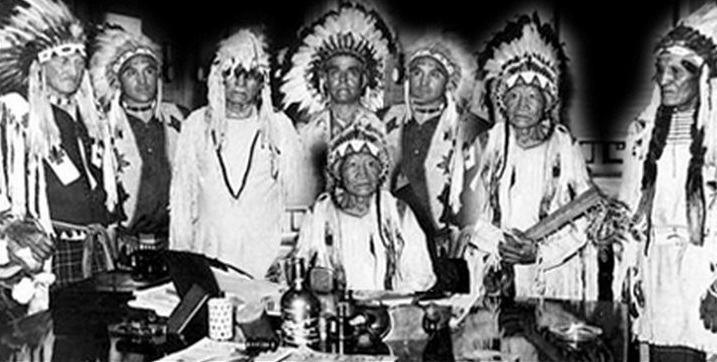
The primary unit of government among the Cherokee was the town. Each town—perhaps 50 at the time of first European contact—was autonomous. The government of each town was not tied to the government of other towns. These Cherokee towns were loosely affiliated into three groups: (1) the Lower Towns on the headwaters of the Savannah River (including the towns of Keowee and Estatoe), (2) the Middle Towns on the headwaters of the Little Tennessee River (including Etchoe, Stecoe), and (3) the Upper Towns (Overhill and Valley) on the Lower Little Tennessee River and the headwater of the Hiwassee River (including Settico and Tellico).
Each Cherokee village had two governments: a white government which governed when the village was at peace, and a red government which governed during times of war. The white government included the chief who was given the title Beloved Man; the chief’s advisor; counselors from each clan; a council of elders; a speaker; messengers; and ceremonial officers. The red government included the Great War Chief; the Great War Chief’s Second; seven war counselors; a War Woman; the Chief War Speaker; messengers; ceremonial officers; and scouts. The fate of captives and war prisoners was decided by the War Woman.
Among the Cherokee, all were able to participate in the councils. Cherokee society tended to be egalitarian rather than hierarchical. The chiefs had an advisory role and their power lay in their ability to persuade through oratory. According to historian John Finger in his book The Eastern Band of Cherokees 1819-1900: “There were no leaders in the European sense, no king or prince who wielded coercive authority over others.”
After the chiefs spoke, each person had an opportunity to speak. Issues were discussed until consensus was reached. The council did not pass laws nor regulate conduct, but sought to resolve differences and difficulties.
During the first half of the eighteenth century, Cherokee government had to face the challenges of co-existing with intruding English colonists. According to the English worldview, there was only one legitimate form of government: a monarchy in which power was passed down through the paternal line from father to son. The English had a great deal of difficulty in trying to understand the matrilineal system of the Cherokees and other American Indian nations in which each person belonged to the mother’s clan.
The English viewed leadership as coercive—that is, the leader had the right to tell others what to do. The idea of consensus, the basis of Cherokee government, was an alien concept to them. In their dealings with the Cherokee and other Indian nations, the English preferred to impose their own concepts of an authoritative monarchy on Indian nations.
Another point of conflict between the English view of government and the Cherokees was over the role of women. While English women had few rights, Cherokee women were full participants in Cherokee government. Women were important in Cherokee government because of their leadership within the matrilineal clan system. In the war council, women were present and were consulted with regard to strategy. Grace Steele Woodward, in her book The Cherokees, reports: “Custom dictated that an assemblage of war women or Pretty Women be present at every war council. And since the war women had themselves won previous honors in wars and were the mothers of warriors, they played an important role in Cherokee war councils.”
Initially, the English sought to establish a trading relationship with the Cherokees. In 1673, Virginia trader Abraham Wood sent James Needham and Gabriel Arthur out from Fort Henry to establish trade with the Cherokee at their capital of Chota. The English colony was in need of Cherokee furs, hides, beeswax, and bears’ oil for export to England.
In 1684, the formal government-to-government relationship between the Cherokees and the English was established with a formal treaty between the English and the Cherokee towns of Toxawa and Keowa.
At a meeting with the leaders from 37 Cherokee towns in 1721, the British governor, being more comfortable with a single leader, simply appointed Wrosetasatow (Mankiller or Outacite) as the supreme chief or “king” of the Cherokee. The English felt that it would be easier to deal with only one chief to fix the boundaries between the Cherokee nation and the European settlements.
With a common danger from the English settlers, the Cherokee villages came together to elect a principal chief to represent all of the villages in 1721. The concept of Cherokee nationality as opposed to village autonomy began to emerge. According to historian Marion Starkey in The Cherokee Nation: “The Cherokees, a reasonable people, willing to learn from their enemies, found this innovation of practical value and did not discard it.”
At this time, it was estimated that the Cherokees were living in 53 towns which ranged in population from 62 to 622. The total Cherokee population was estimated at 10,434.
In traditional Cherokee government, when individuals did not agree with the line of reasoning that was gaining acceptance within the council, they would simply withdraw. Thus, in 1721, a group of Cherokee led by Yunwi-usgaseti (Dangerous Man) moved west across the Mississippi River to escape the colonists’ insatiable demands for land and the Cherokee government’s acquiescence to these demands. After Yunwi-usgaseti’s group crossed the Mississippi River there was no further communication with the Cherokee who remained behind in the Southeast. However, oral tradition records that many years later a runner came from the west to report that they were still living at the base of the Rocky Mountains.
In 1730, Sir Alexander Cuming traveled to the Cherokee town of Keowee. He brazenly entered the council house wearing pistols and a sword (a violation of Cherokee tradition) where 300 town elders were meeting. He demanded that they recognize the authority of the English King and threatened to burn down the council house if they did not. Journalist Stanley Hoig, in his book The Cherokees and Their Chiefs: In the Wake of Empire, reports: “Cuming’s audacity, however, overwhelmed the Cherokee leaders, and they on bent knee pledged their loyalty to the Crown of England against the French in North America.” Cuming appointed Moytoy of Tellico as the Cherokee “emperor.”
In reviewing the historical accounts of this event, Cherokee historian Robert Conley, in his book The Cherokee Nation: A History, concludes: “The story is absurd.” Conley acknowledges that Cuming visited the Cherokee and talked with people in the townhouses, but points out that “whatever he accomplished, he certainly embellished the tale for the benefit of King George.” Conley writes: “It is easy to believe that the egotistical King George II was taken in by Cuming’s fabrication. What is astonishing is that almost all historians ever since writing about the Cherokees have also been gullible enough to accept it at face value. In the first place, it has always been extremely difficult, if not impossible, to get all Cherokees to agree on anything. In the second place, the Cherokees have always (at least since the time of the killing of the Ani-Kutani) been almost fanatical about democracy.”
With regard to Moytoy being selected as “emperor”, it was more likely that the Cherokee selected Moytoy to be their trade representative in dealing with the English traders.
In 1753 the Cherokee villages delegated to the town of Chota the power to negotiate trade and diplomatic relations for the entire Cherokee nation. In a trade agreement with the Carolinas, Old Hop was declared the Cherokee emperor by the British.
In 1753, a delegation of Cherokee leaders under the leadership of Attakullakulla met with the British governor in South Carolina. The Cherokee assured the British of their loyalty. The British governor informed the Cherokee that the purpose of the council was to establish peace between the Cherokee and the Creek. Attakullakulla argued with the governor, telling him that when he had spoken with the King, the King had asked the Cherokee to avenge the lives of his people taken by the Creek. While the governor insisted that he spoke for the King, Attakullakulla said that he should go to England to speak with the King in person. Attakullakulla reminded the governor of the treaty which the Cherokee signed in England which had promised them goods. He said: “I remember the great King George’s talk, for the paper said the governor of Carolina was to supply us with all kinds of goods, but if he did not, we might have them in Virginia.” In the end, the governor agreed to provide the goods.
In 1755, the British governor of South Carolina met with the Cherokee to ask them to sell their landholdings in areas in which there were no active Cherokee towns. Old Hop, unaccustomed to speaking with the British, asked the Cherokee council to select someone to represent the welfare of the Cherokee people. The council selected Attakullakulla. Attakullakulla presented a young boy to the British governor saying: “I have brought this child that when he grows up he may remember our agreement this day and tell it to the next generation that it may be known forever.”
As a result of the council, the Cherokee agreed to provide the British with warriors and to give up their land in South Carolina. In return, the British agreed to provide the Cherokee with guns and ammunition and to build forts to protect the Cherokee.
While the Cherokee nation had changed its government during their interactions with the English colonial government and had begun to function with regard to its national interests rather than just the interests of the individual villages, there were even more challenges to their form of government ahead.
In 1776 a group of American colonists signed the Declaration of Independence which condemned King George III for preventing the colonists from appropriating western lands which belonged to Indian nations. The Revolutionary War divided the Indian nations as both the British and the newly formed United States tried to obtain Indian allies. As a result of the war, the Cherokee nation’s government had to change again to meet the incessant demands of the newly formed United States.
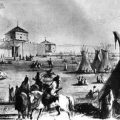
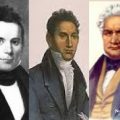
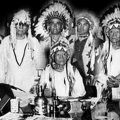
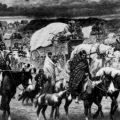
Leave a Reply